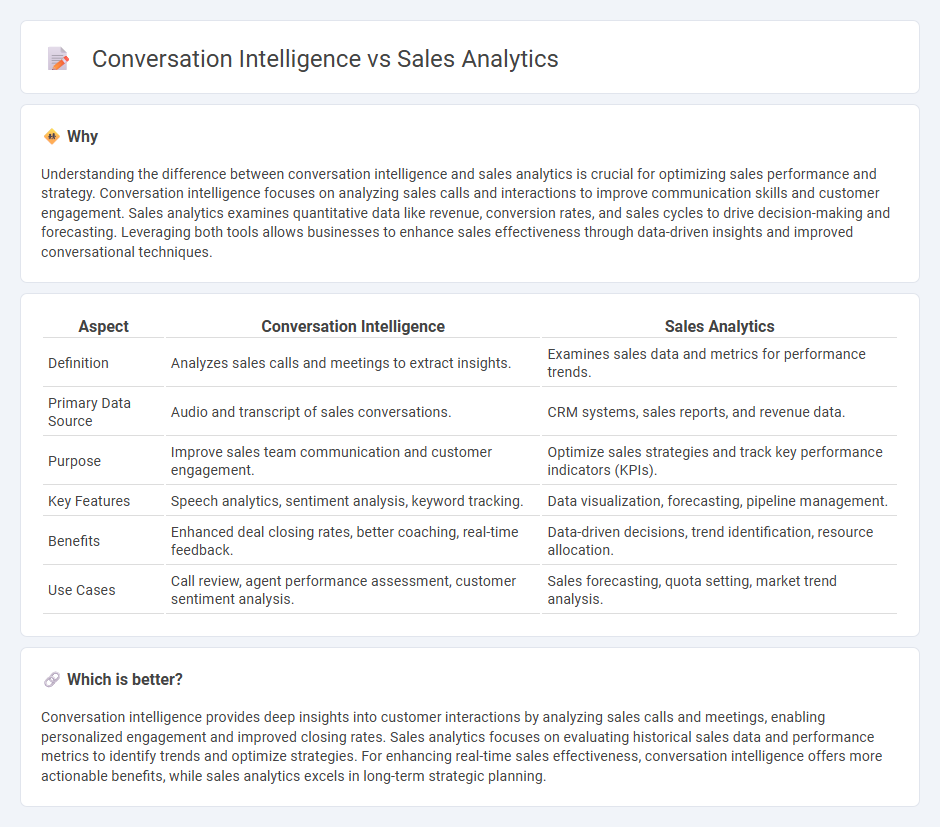
Conversation intelligence captures and analyzes real-time sales interactions to uncover customer insights, improve communication strategies, and boost closing rates. Sales analytics examines historical data, performance metrics, and sales funnels to identify trends, forecast outcomes, and optimize processes. Discover how integrating conversation intelligence with sales analytics can transform your sales approach.
Why it is important
Understanding the difference between conversation intelligence and sales analytics is crucial for optimizing sales performance and strategy. Conversation intelligence focuses on analyzing sales calls and interactions to improve communication skills and customer engagement. Sales analytics examines quantitative data like revenue, conversion rates, and sales cycles to drive decision-making and forecasting. Leveraging both tools allows businesses to enhance sales effectiveness through data-driven insights and improved conversational techniques.
Comparison Table
| Aspect | Conversation Intelligence | Sales Analytics |
|---|---|---|
| Definition | Analyzes sales calls and meetings to extract insights. | Examines sales data and metrics for performance trends. |
| Primary Data Source | Audio and transcript of sales conversations. | CRM systems, sales reports, and revenue data. |
| Purpose | Improve sales team communication and customer engagement. | Optimize sales strategies and track key performance indicators (KPIs). |
| Key Features | Speech analytics, sentiment analysis, keyword tracking. | Data visualization, forecasting, pipeline management. |
| Benefits | Enhanced deal closing rates, better coaching, real-time feedback. | Data-driven decisions, trend identification, resource allocation. |
| Use Cases | Call review, agent performance assessment, customer sentiment analysis. | Sales forecasting, quota setting, market trend analysis. |
Which is better?
Conversation intelligence provides deep insights into customer interactions by analyzing sales calls and meetings, enabling personalized engagement and improved closing rates. Sales analytics focuses on evaluating historical sales data and performance metrics to identify trends and optimize strategies. For enhancing real-time sales effectiveness, conversation intelligence offers more actionable benefits, while sales analytics excels in long-term strategic planning.
Connection
Conversation intelligence leverages AI to analyze sales calls and meetings, extracting valuable insights about customer sentiment, objection handling, and sales rep performance. Sales analytics integrates this data to identify trends, predict outcomes, and optimize sales strategies based on real-time conversational patterns. Together, they enable data-driven decision-making that enhances revenue growth and improves customer engagement.
Key Terms
Sales Analytics:
Sales analytics leverages data from CRM systems, sales performance metrics, and pipeline analysis to identify trends and improve forecasting accuracy. It uses key performance indicators (KPIs) such as conversion rates, average deal size, and sales cycle length to optimize sales strategies and resource allocation. Explore our detailed guide to understand how sales analytics can transform your revenue growth.
Pipeline Metrics
Sales analytics and conversation intelligence both enhance pipeline metrics by providing distinct insights; sales analytics delivers quantitative data on lead conversion rates, deal velocity, and revenue forecasts, while conversation intelligence captures qualitative details from customer interactions, revealing sentiment, objections, and engagement levels. Pipeline efficiency improves when combining these tools, enabling teams to identify bottlenecks, optimize communication strategies, and prioritize high-value opportunities based on data-driven insights. Explore how integrating sales analytics with conversation intelligence can transform your pipeline management and boost overall sales performance.
Forecasting
Sales analytics leverages historical sales data and performance metrics to predict future revenue trends and identify potential growth opportunities. Conversation intelligence analyzes customer interactions and communication patterns to gain insights that enhance sales forecasting accuracy by capturing real-time market sentiments. Explore how integrating these technologies can refine your forecasting strategies and drive better business outcomes.
Source and External Links
What Is Sales Analytics? +11 Must-Track Metrics (2025) - Whatfix - This webpage provides an overview of sales analytics, highlighting its importance in optimizing sales strategies and improving revenue.
What is Sales Analytics? - DealHub - This article describes sales analytics as a process to analyze sales data for improving performance and making better business decisions.
Sales Analytics 101: Everything You Need To Know - Shopify - This guide covers the basics of sales analytics, including key metrics and steps for conducting sales data analysis to inform business decisions.
 dowidth.com
dowidth.com